TL;DR
Stablecoins have long been regarded as the "crown of the cryptocurrency industry", but early developments have focused on algorithmic stablecoins, such as Ampleforth's AMPL and Terra's UST (LUNA). These projects attempt to break away from their reliance on U.S. dollar assets and build encapsulated "dollar stablecoins" through algorithmic mechanisms, with the goal of promoting the large-scale application of stablecoins in the crypto and DeFi ecosystems, and ultimately expanding to traditional off-chain users. In addition, there are significant differences in the path choices between the two. Ampleforth is committed to creating a native settlement unit that belongs entirely to the crypto world, so it does not maintain a 1:1 peg to the U.S. dollar; TerraUSD (UST) attempts to maintain a stable anchor with the U.S. dollar so that it can be more widely used as a payment and value storage tool.
This year, with the emergence of Ethena, DeFi stablecoins are no longer just anchored to price stability, but have begun to anchor to "sources of income". A new type of "strategic stablecoins" is emerging, which essentially package hedging strategies or low-risk income products into $1 tradable tokens. For example, Ethena's USDe is similar to a fund share, which generates income through a delta-neutral strategy of going long on stETH and shorting perpetual contracts, and distributes it to holders in the form of sUSDe. This type of stablecoin structure is similar to the subscription shares of hedge funds, so it is regarded as a security by regulators such as Germany's BaFin.
When systematically combing the income mechanism behind stablecoins, the article summarizes them into nine categories, including on-chain lending, real assets (RWA), AMM market making, CeFi deposits, protocol savings rate (such as DSR), fixed-rate notes, derivatives hedging, pledge income and strategy aggregation Vault. The annualized income of each channel is roughly concentrated in the 3-8% range in the current market, and can briefly exceed double digits in some special periods (such as USDC de-anchoring and high funding fees).
Although current strategic stablecoin projects appear to be highly homogenized on the surface, their core differences are actually reflected in three key dimensions: whether the income structure is sustainable, whether the income disclosure is transparent, and whether it is based on compliance. At present, stablecoins based on real-world assets (RWA), such as USDY and OUSG, are relatively superior in terms of compliance and have obtained a certain degree of regulatory recognition, but their growth ceiling is limited by the market structure of the U.S. Treasury market. Relatively speaking, derivative-linked stablecoins such as USDe offer greater flexibility and income potential, but at the same time they are more dependent on the open positions (OI) in the perpetual contract market and are more sensitive to market fluctuations.
In this trend, the infrastructure project that benefits the most is Pendle. The protocol builds an interest rate market on the chain by decomposing income assets into fixed principal (PT) and floating income (YT), thereby promoting the standardized development of "interest rate hedging" and "income transfer". As more and more stablecoin projects adopt Pendle to manage their cash flow, its TVL, transaction volume and bribe mechanism are expected to achieve further growth.
We believe that future strategic stablecoins will evolve towards modularization, regulatory friendliness, and clear returns, and projects with unique revenue sources, good exit mechanisms, and liquidity moats (ecological adoption) will become the cornerstone of the next "on-chain money fund." However, such products may still be identified as securities by regulators, and potential compliance challenges cannot be ignored.
Stablecoins based on strategies
There are many channels for income-generating stablecoins, including lending agreements, liquidity mining, market neutral arbitrage, RWA U.S. Treasury yields, option structured products, a basket of stablecoins, and stablecoin staking. The following is a summary of some income strategies:

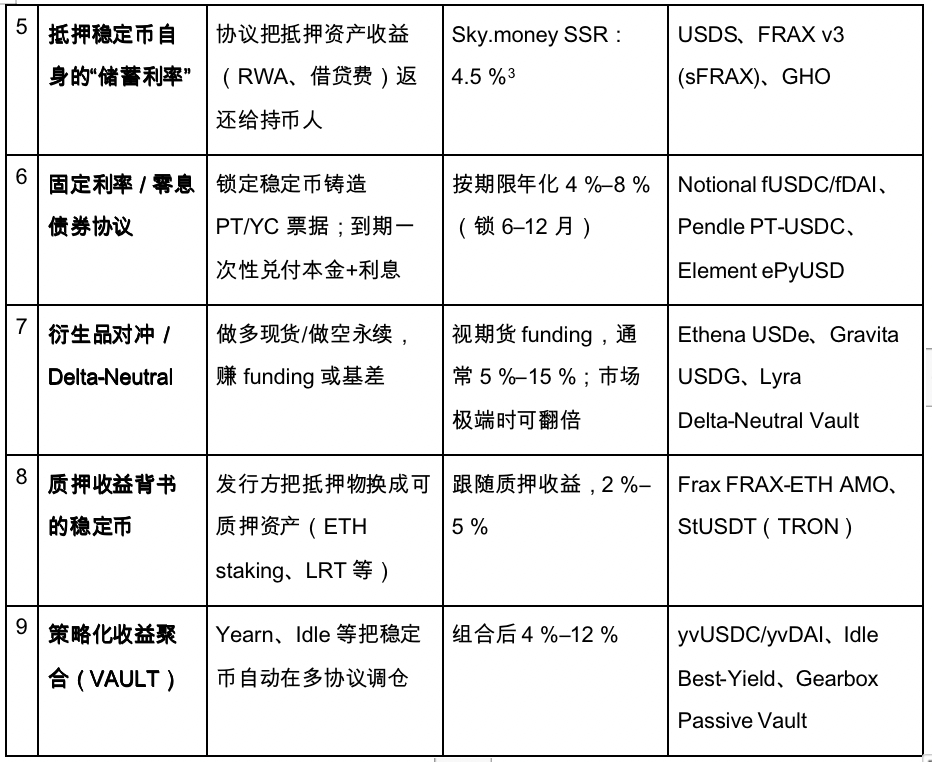
We will conduct an in-depth analysis of the current status and catalysts of some major innovative interest rate channels to determine future development prospects.
On-chain lending market

AAVE V3 USDC, source: AAVE
The above chart shows the lending rate of USDC on the AAVE V3 Ethereum mainnet, which is usually regarded as the "benchmark rate" for on-chain lending. In the current context of low market sentiment and insufficient capital demand, lending activity has declined significantly, causing interest rates to remain roughly at a low level of around 2% since the beginning of the year.
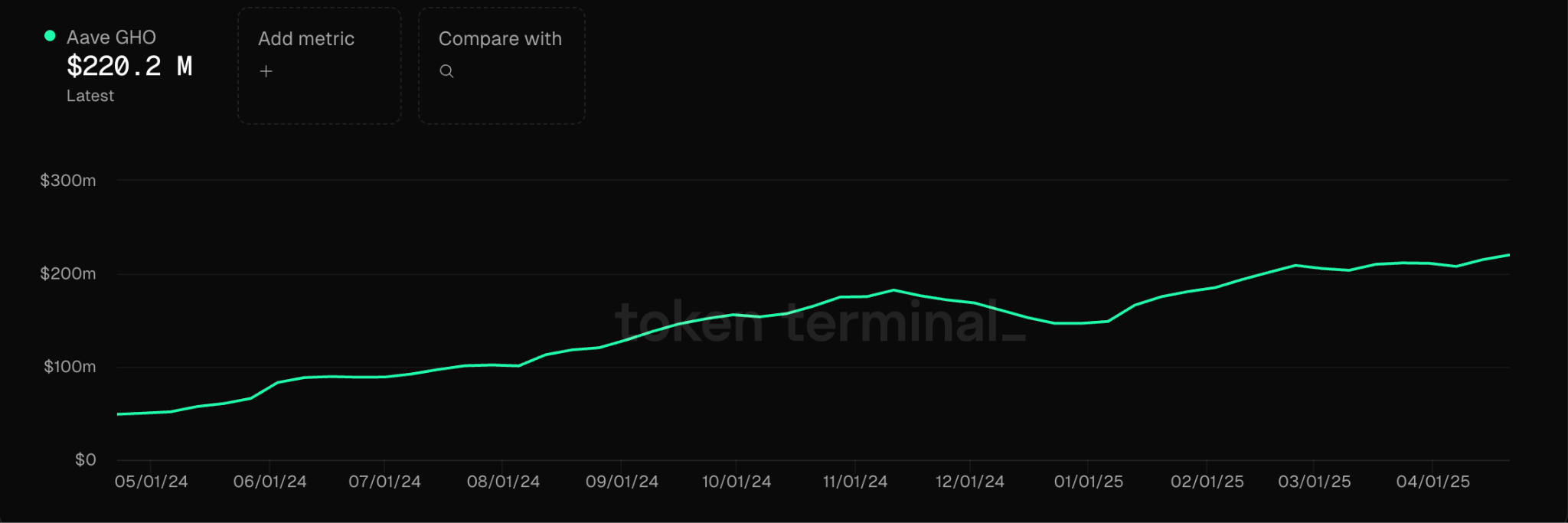
At the same time, AAVE launched its native stablecoin GHO, which is supported by an over-collateralized mechanism, and its interest rate is also derived from market lending demand. Although most mainstream stablecoins can earn interest on the platform, they must be achieved through lending, which limits capital efficiency. At present, the borrowing rate of GHO fluctuates in the range of about 2-4%, which is greatly affected by the market cycle. In the bull market stage, this type of lending rate can jump to 10% -20%, but the overall volatility is strong and the stability is insufficient. In such a high-volatility interest rate scenario, Pendle can be used as a tool to redeem this part of the interest in advance. At this time, you can consider using Pendle to cash in this part of the interest in advance.
RWA Market (mainly government bonds)
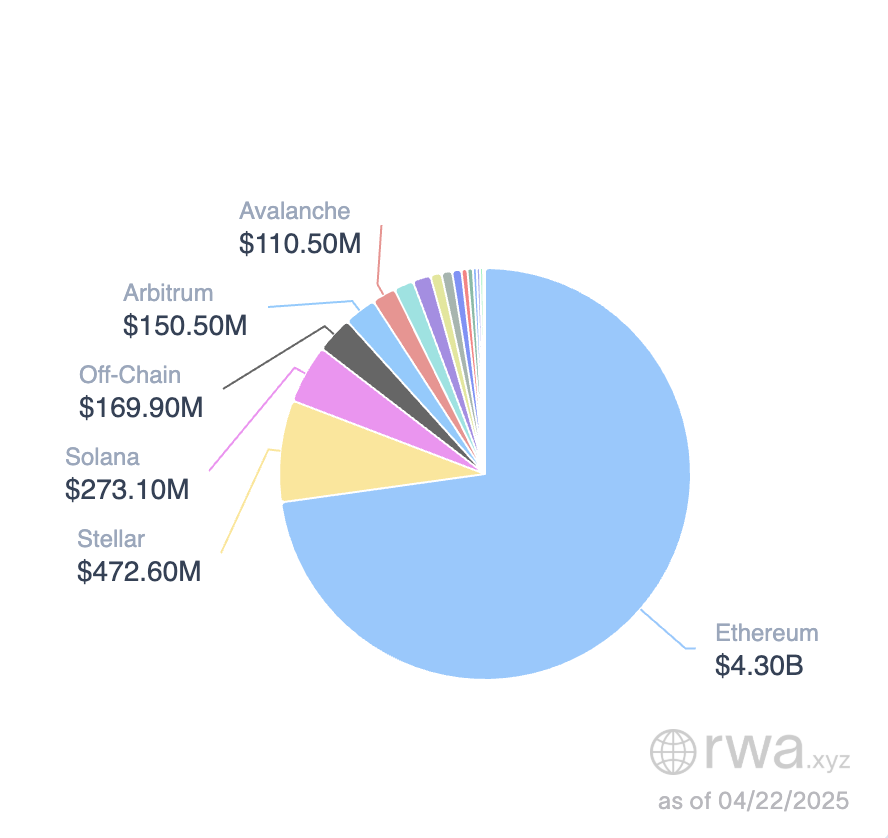

Opportunity RWA market stablecoin, source: RWA.xyz
At present, stablecoins based on national debt are gradually growing, and the current total market size is 5.9 billion US dollars. Among them, the Ethereum ecosystem occupies a dominant position, covering more than 80% of the market share. In terms of stablecoin categories, BUILD issued by Balckrock occupies the main market share of stablecoins based on national debt (32%), about 1.9 billion US dollars; followed by USYC issued by Circle (490 million US dollars) and BENJI issued by Franklin Templeton.

BUIDL Supply, source: Dune
Take BUIDL as an example. Although it is pegged to $1, it is not a stablecoin that can be used for daily payments. Instead, it is a fund share that is benchmarked against short-term US Treasury bonds, cash, and overnight repurchase agreements. Users can subscribe through USDC/USD. Each BUIDL corresponds to $1 principal, and the income is distributed through the monthly rebase mechanism. Early participants include Anchorage Digital Bank NA, BitGo, Coinbase, and Fireblocks.
The supply scale of BUIDL is growing rapidly, and the current minimum subscription threshold is US$5 million. As of May 1, 2025, 48 clients have participated, with a total asset management scale (AUM) of US$2.47 billion. According to Ondo Finance statistics, the annualized rate of return (APY) of this product is about 4%, which corresponds to the current US Treasury bond interest rate level of 3 to 6 months.

USDtb TVL, source: Defillama
USDtb launched by Ethena is an innovative attempt based on the existing money fund stablecoin. This product is built with BUIDL tokenized fund as the underlying asset. Unlike Ondo's OUSG and BlackRock's BUIDL, USDtb has achieved free circulation. At present, its asset management scale is about 1.43 billion US dollars, and it has reached in-depth cooperation with Bybit, and the overall market liquidity performance is good.
Overall, the RWA-based stablecoin market is expanding rapidly, with a total size of approximately $5.9 billion. Ethena's USDtb provides a new direction reference: if the US regulator allows the "interest-bearing stablecoin" model in the future, the market cap of this type of product can theoretically be comparable to the US dollar money market fund, reaching a scale of $6 trillion.
However, in the short and medium term, there is downward pressure on US Treasury bond interest rates. In the current context where stablecoins are mainly driven by interest rates rather than actual payment demand, stablecoin strategies based on money market funds may face shrinking returns in the short term. However, from a long-term perspective, this track still has strong growth potential.
The “savings rate” of the collateralized stablecoin itself
DSR (Dai Savings Rate) was originally launched by MakerDAO and has now evolved into the SSR (Stablecoin Savings Rate) module in Sky.money. This module allows USDS holders to obtain a share of the protocol revenue at an annualized interest rate. The interest is calculated in real time by block, there is no lock-up, no handling fee, and users can deposit and withdraw at any time.
The income comes from the profits generated by MakerDAO/Sky.money. In order to promote the wider use of USDS in DeFi, Sky.money has set up an incentive mechanism to allocate part of the protocol income to the USDS savings rate. The current interest rate is about 4.5% annualized.
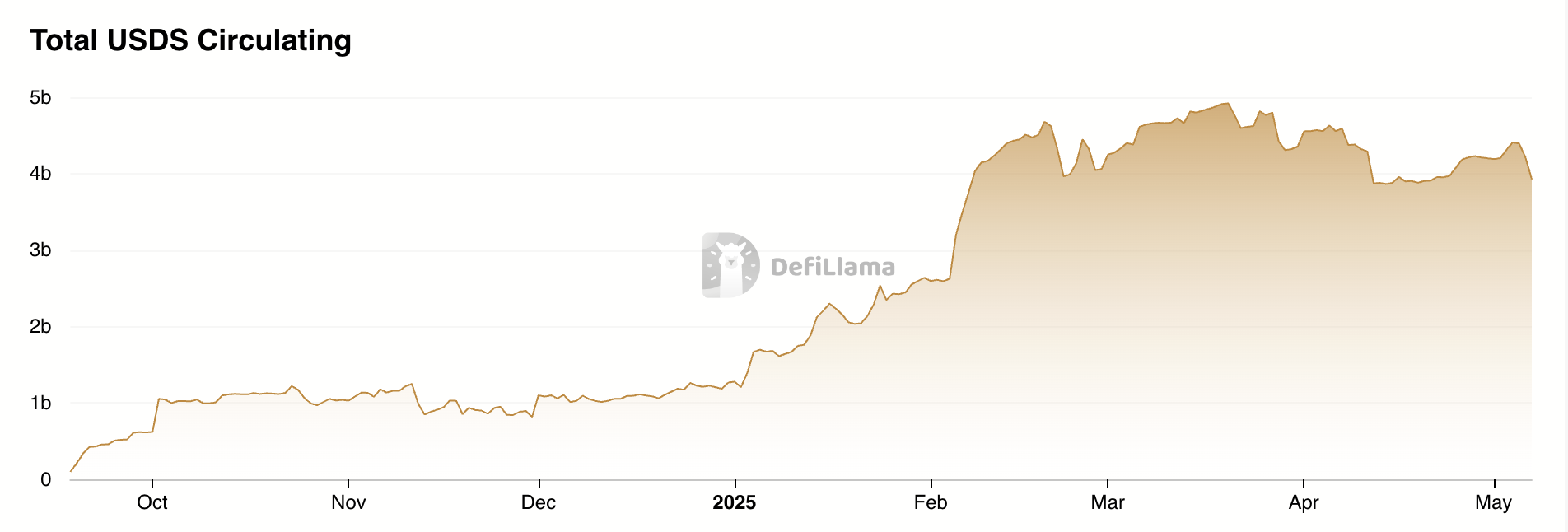
USDS Growth, source: Defillama
In essence, this is a protocol dividend stablecoin model. When the market is down, Sky.money will divert the income originally used to empower native tokens to USDS in order to promote the use of USDS, which may weaken the price support of native tokens. When the market is good, moderately transferring token income in exchange for overall protocol growth will help increase the price of the currency, which is a reasonable strategy. Because this model is deeply bound to the protocol, Sky.money needs to have enough influence to truly promote USDS to become a widely used unit of account, which is extremely challenging in itself and shows great ambition.
Derivatives hedging + staking income
Derivatives hedging rate (also known as Delta-neutral rate) is a source of income based on the derivatives market. It locks in price direction risk (Delta) by holding both forward and reverse positions, and earns income from funding fees (Funding Rate) or the spread between futures prices and spot prices. In the derivatives market, perpetual futures are the main object. There are several types of income:

Some representative projects are as follows:
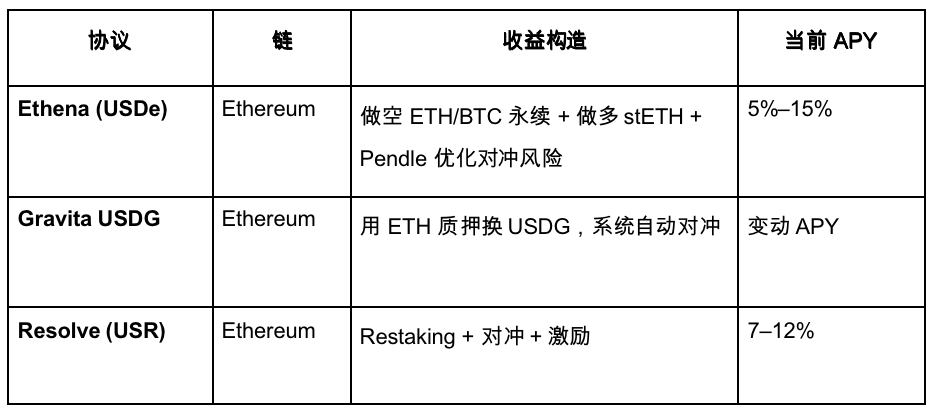
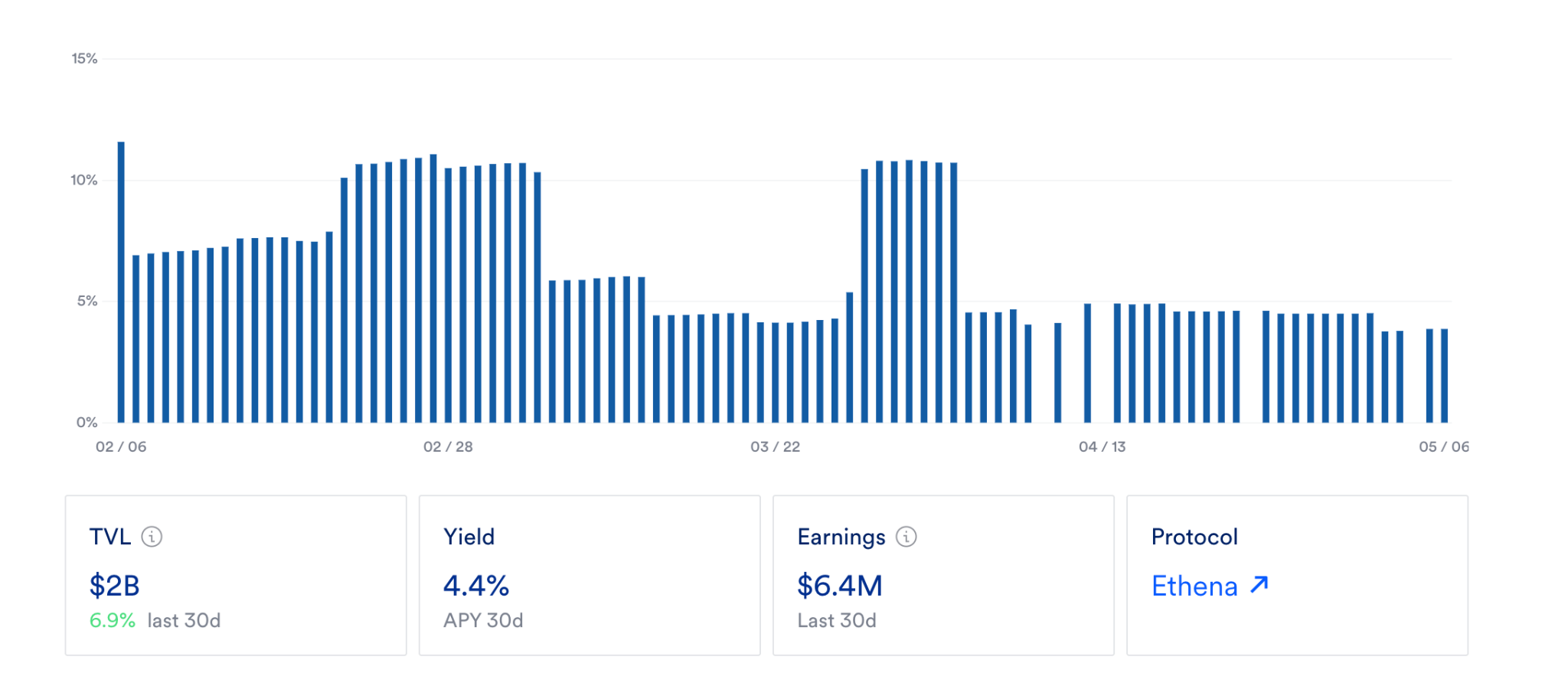
USDe APY, Source: Exponential.FI
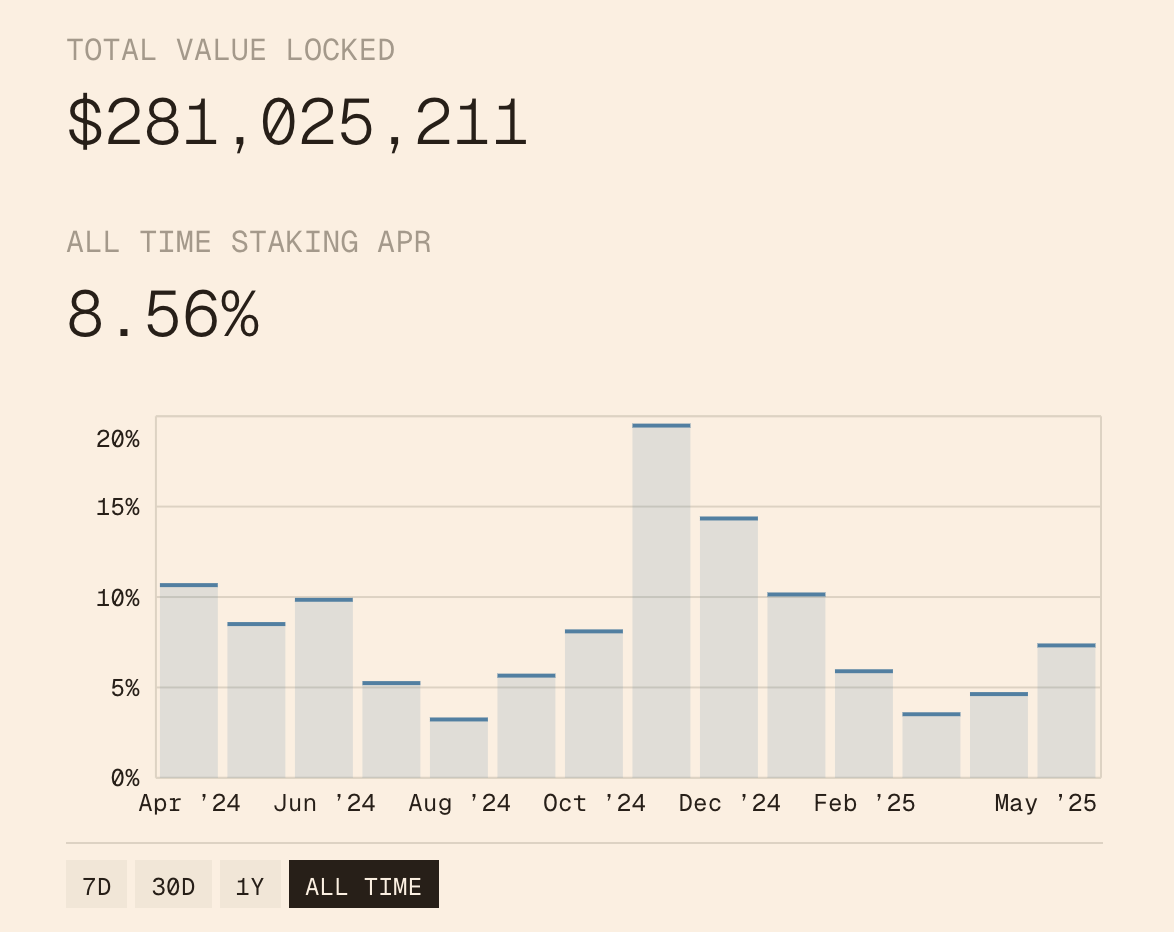
USR APR, source: Resolve
The above are the changes in the stablecoin interest rates of USDe and USR respectively. Overall, USDe is the first stablecoin with a neutral interest rate, and USR is a follower. The current promotion strategy is to adopt a higher interest rate to attract user deposits, but there is not much essential difference from Ethena.
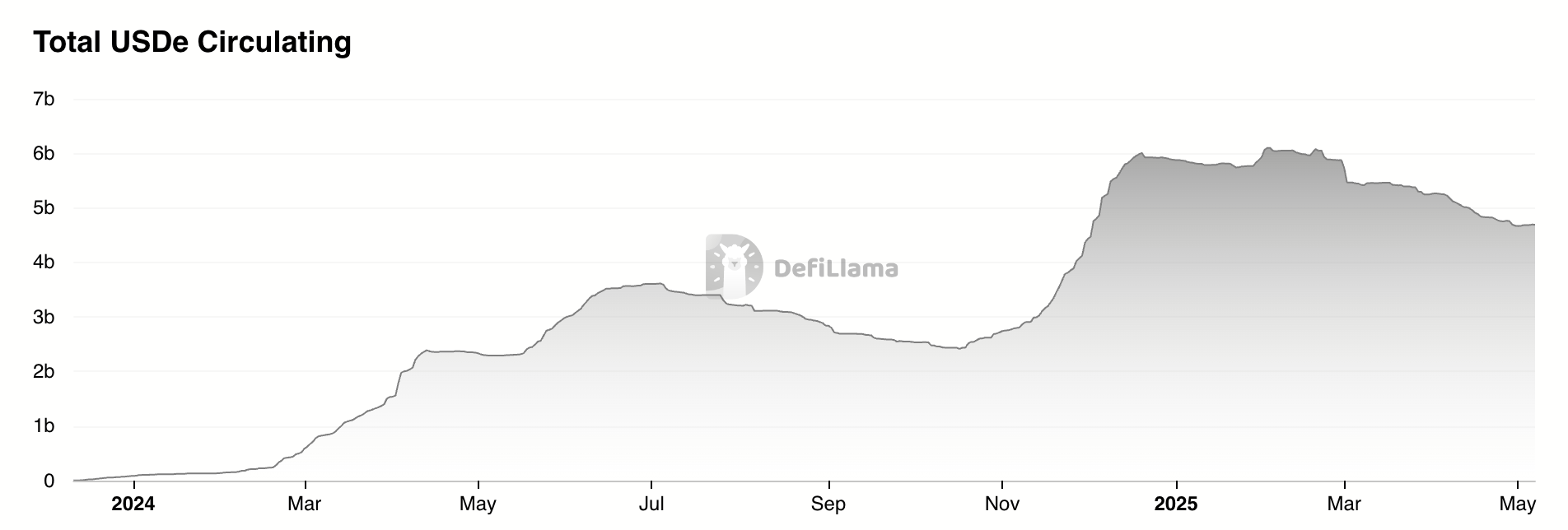
USDe TVL, source: Defillama
According to Defillama data, the market value of Ethena stablecoin has declined significantly after the airdrop, and has fallen by about 20% from its peak. This is mainly affected by the downward trend of USDe yields; secondly, current stablecoins generally face the dilemma of "financial Lego" - that is, the lack of rigid demand in the real world, and in essence, it is more like arbitrage of funding fees by building fund products.
Funding‑rate stablecoins (Δ‑neutral stablecoins) are minted in the following way:
1. Purchase the same amount of spot (or LST)
2. Open a short position at the same par value in the perpetual market
Therefore, every $1 of stablecoin minted ≈ $1 spot + $1 nominal short position, which means that the scale of minting is theoretically limited by the existing position (OI) in the perpetual market.

Ethereum OI, source: Coinglass
According to Coinglass statistics, the total OI of ETH on major exchanges is currently about US$20 billion. According to conservative estimates, the market cap of USDe is about US$4 billion.

All tokens' OI, source: Coinglass
If the total OI of the entire network is taken into account, the market size of hedging strategies based on contract interest rates is about US$120 billion. According to conservative estimates, this type of strategy can obtain about 20% of the market share, or about US$24 billion.
In other words, the market share of the entire contract interest rate hedging strategy track is conservatively estimated to be US$24 billion. Based on this, the potential market size of USDe, which focuses on the ETH market, is roughly between US$4 billion and US$8 billion. The current minting scale of USDe is about US$4.6 billion, and it is showing a downward trend, which means that its growth has gradually approached the upper limit and there is a relatively obvious ceiling.
Policy Aggregation Vault
For example, Idle Best-Yield has deployed an automated strategy system on Ethereum and Polygon, which can dynamically adjust positions based on on-chain arbitrage opportunities to obtain the maximum stablecoin returns; Hyperliquid's HLP can also be regarded as a strategic stablecoin income pool, whose income source is mainly the counterparty strategy in the opposite direction of retail investors. Although this type of multi-strategy model brings higher returns, it is also accompanied by higher risk exposure.
Binance launches LDUSDT
We always need to be very cautious about this type of stablecoin, because it is essentially a subscription for hedge fund shares. As Binance introduced LDUSDT, LDUSDT is not a stablecoin, but a new type of margin asset designed for users who subscribe to Simple Earn USDT current financial products. It is a package of USDT, which can be used as a valuation asset for contract margin and can also obtain the annualized interest of Binance simple earn. Therefore, its underlying interest depends on the lending market of the Simple earn module of the Binance platform.
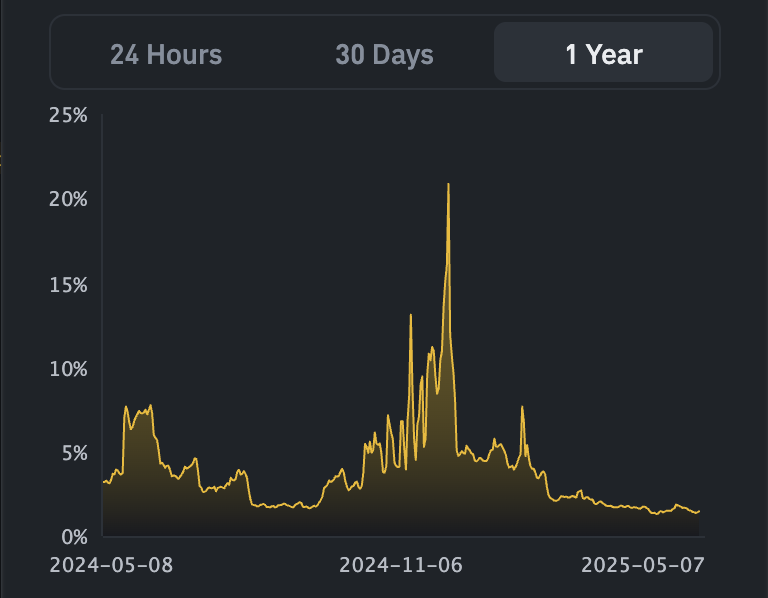
Simple earn APR, source: Binance
The strategic stablecoin represented by Ethena USDe may be an innovative form. Overall, the rise of strategic stablecoins reflects the conservative trend of the crypto market to some extent, but it can also be seen as an improvement. Unlike the previous round of stablecoins that relied on subsidies to drive growth, the current stablecoins rely more on the actual benefits brought by diversified and organic strategies and have stronger sustainability. However, after excluding the Points or token airdrop subsidies, its annualized rate of return has no obvious advantage over government bonds.
At the same time, the synergy of the DeFi world has not been fully stimulated, resulting in stablecoins still being mainly used for "financial Lego"-style internal gameplay rather than promoting real large-scale applications. Promoting exchanges to launch such synthetic stablecoins is an important step towards large-scale adoption in the Web3 world. At present, Ethena is advancing rapidly in this field. Bybit and Bitget have both launched their trading pairs, and Gate has also reached a strategic cooperation with Ethena. However, the effect is still not ideal, and the 24-hour trading volume of USDE/USDT in the entire network is less than 100 million US dollars.
Overview of Stablecoin Projects
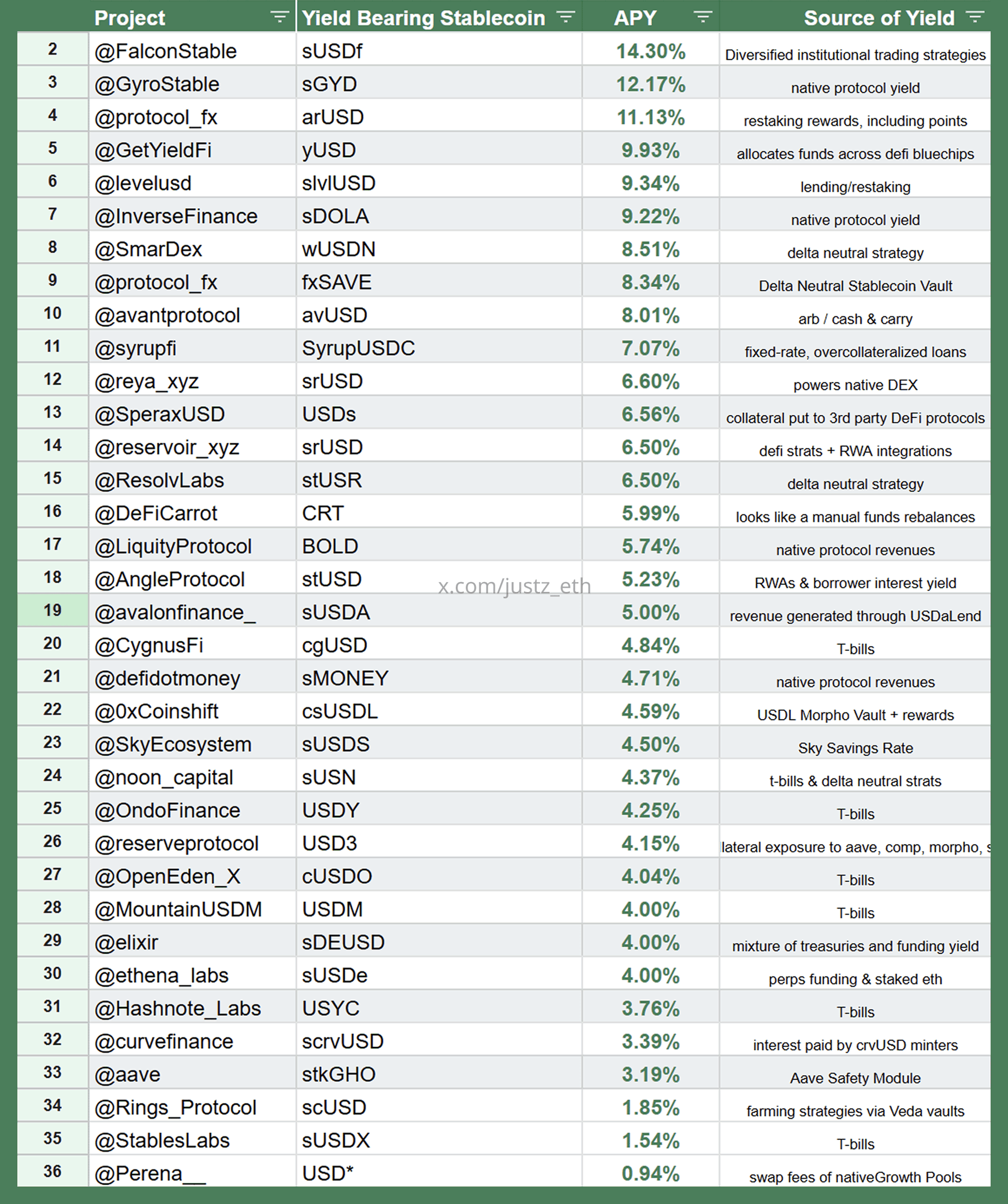
Strategy-backed Synthetic Stablecoins Landscape, source:justz_eth
The above are more strategy-based synthetic stablecoins. The strategy corresponding to the interest source of each stablecoin is also listed in the figure.
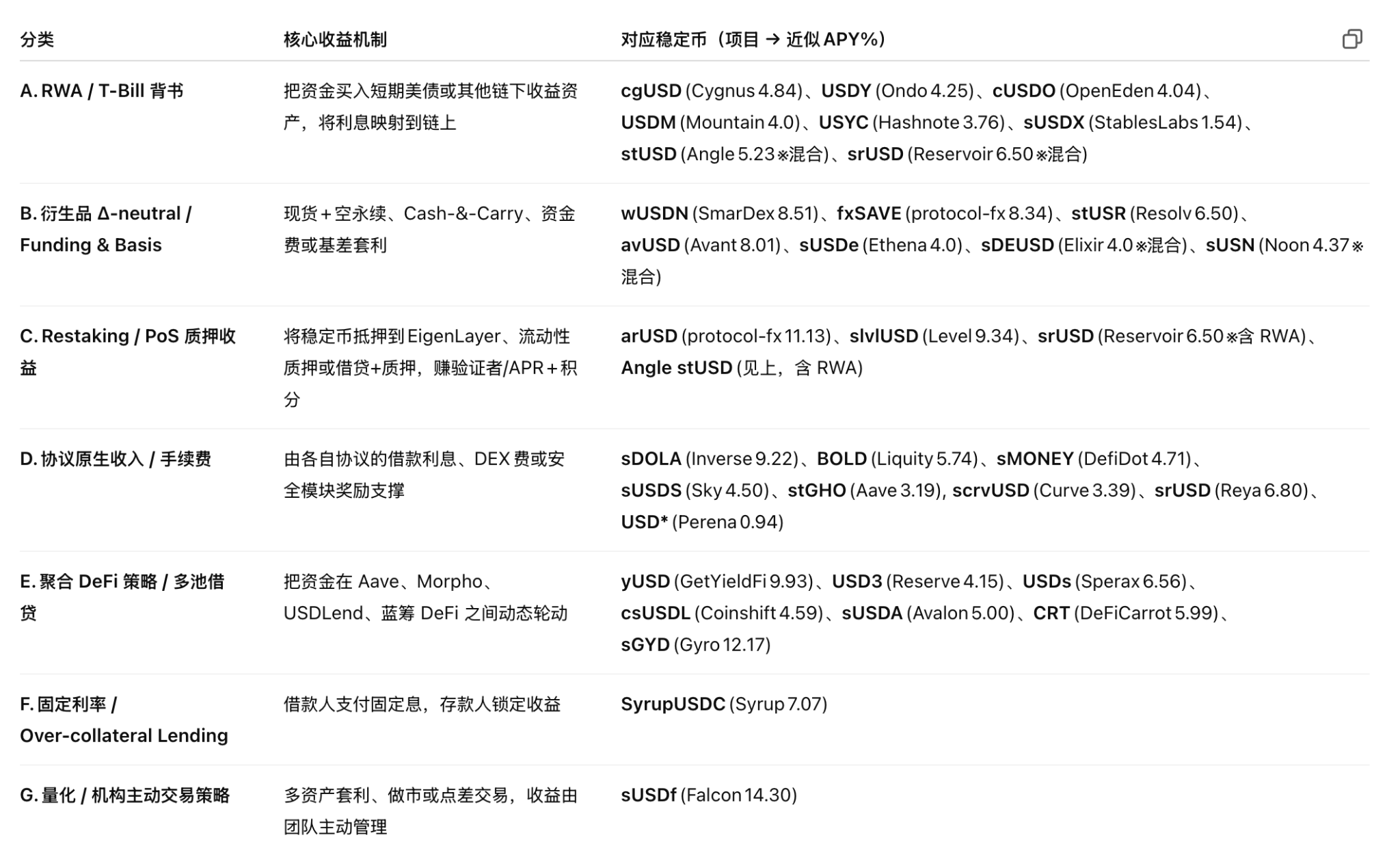
Strategy Classification, source: justz_eth
The underlying synthetic asset interest sources of some popular stablecoin projects in the current market can mostly be classified into the strategies we mentioned above. However, it should be pointed out that the TVL data of many projects may be inflated, and some projects even have special agreements with large investors, so readers should be cautious. In the final analysis, this type of stablecoin is closer to the subscription of hedge fund shares, and therefore there is a legal risk of being identified as a security.
In terms of market share, the stablecoin track based on US Treasury bonds is large in scale, and the implementation of large-scale applications is highly dependent on laws and regulations and strong support from the banking system, so we are relatively more optimistic about such projects. Other strategies, such as lending rates, restaking rates, contract risk-free rates, and protocol income, all have obvious ceilings, and it is recommended to participate moderately.
A new way to play with interest rates
The following are some of our ideas for entrepreneurs’ reference:
1. First of all, it is a new way to play with assets. BTC, as a key asset connecting TradFi and Web3, has a market value of trillions of dollars. If we can rely on BTC-Fi to introduce base interest rates into stablecoins and build a stablecoin system based on the BTC ecosystem, its promotion difficulty may be lower than that of other public chain ecosystems. However, the challenge is that BTC itself lacks ecological infrastructure. We can consider starting from the off-chain, such as starting the first step of contract interest rate arbitrage around BTC, but the overall logic still belongs to the category of strategic hedge funds.
2. The second is the new application of strategies. All arbitrage strategies can theoretically become the source of interest for "stablecoins". For example, on-chain MEV, IV-RV deviation, cross-term volatility arbitrage, GameFi income, and even the security fees provided by EigenLayer AVS or part of the income from DePIN devices may be included in the interest mechanism of stablecoins, thereby deriving a new stablecoin interest rate model.
But in the final analysis, these are still strategy-based synthetic stablecoins, not stablecoins anchored to real assets in the traditional sense. Their market capacity is limited by the feasible space of the strategy itself, that is, the size of the underlying market on which they rely. At present, most related markets are still small. In the long run, with the overall expansion of DeFi, this track has growth potential, especially since many strategies themselves are highly Crypto Native and can more keenly reflect changes in the on-chain market.
Pendle, the beneficiary of the stablecoin war
Fixed rate is an innovative income mechanism that aims to provide users with predictable fixed income, similar to zero-coupon bonds in traditional finance. In traditional finance, zero-coupon bonds are issued at a price below par, and the principal is repaid at par upon maturity, with no interest paid during the period. Investors receive income from the difference between the purchase price and the amount repaid at maturity. In DeFi, a similar mechanism is introduced by Pendle, which tokenizes the future income of income assets, allowing users to:
1. Lock in fixed income: By purchasing tokens representing the principal and holding them until maturity, you can get a fixed return.
2. Speculate on yield: Bet on changes in yields by purchasing tokens that represent future earnings.
3. Improve capital efficiency: Sell future earnings for immediate liquidity while retaining ownership of the principal.
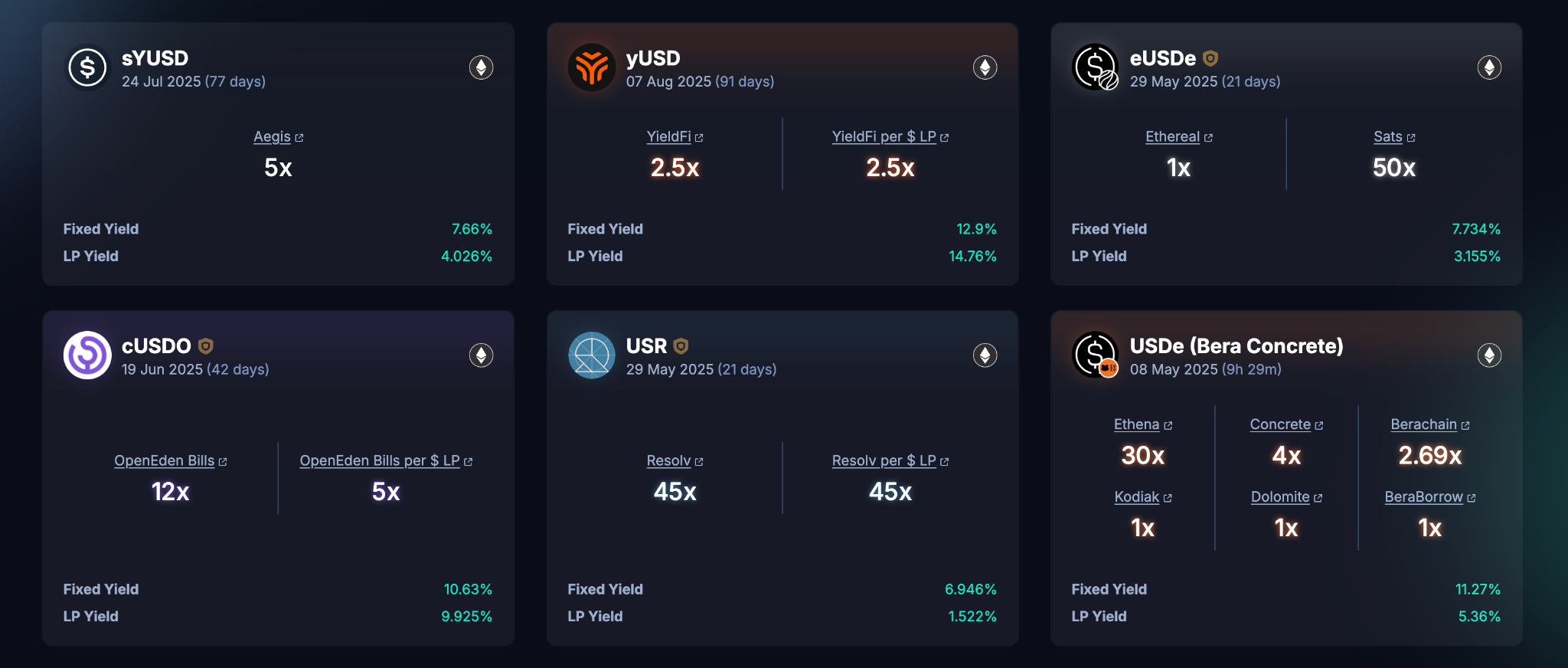
Pendle Snapshot, source:pendle
Pendle is a DeFi protocol focused on yield tokenization, allowing users to split yield assets into two tokens, PT and YT, and trade them on its platform. In essence, Pendle has built a trading market for these interest rates themselves, providing a means of hedging the yield strategy behind stablecoins, thereby forming a fixed interest rate.
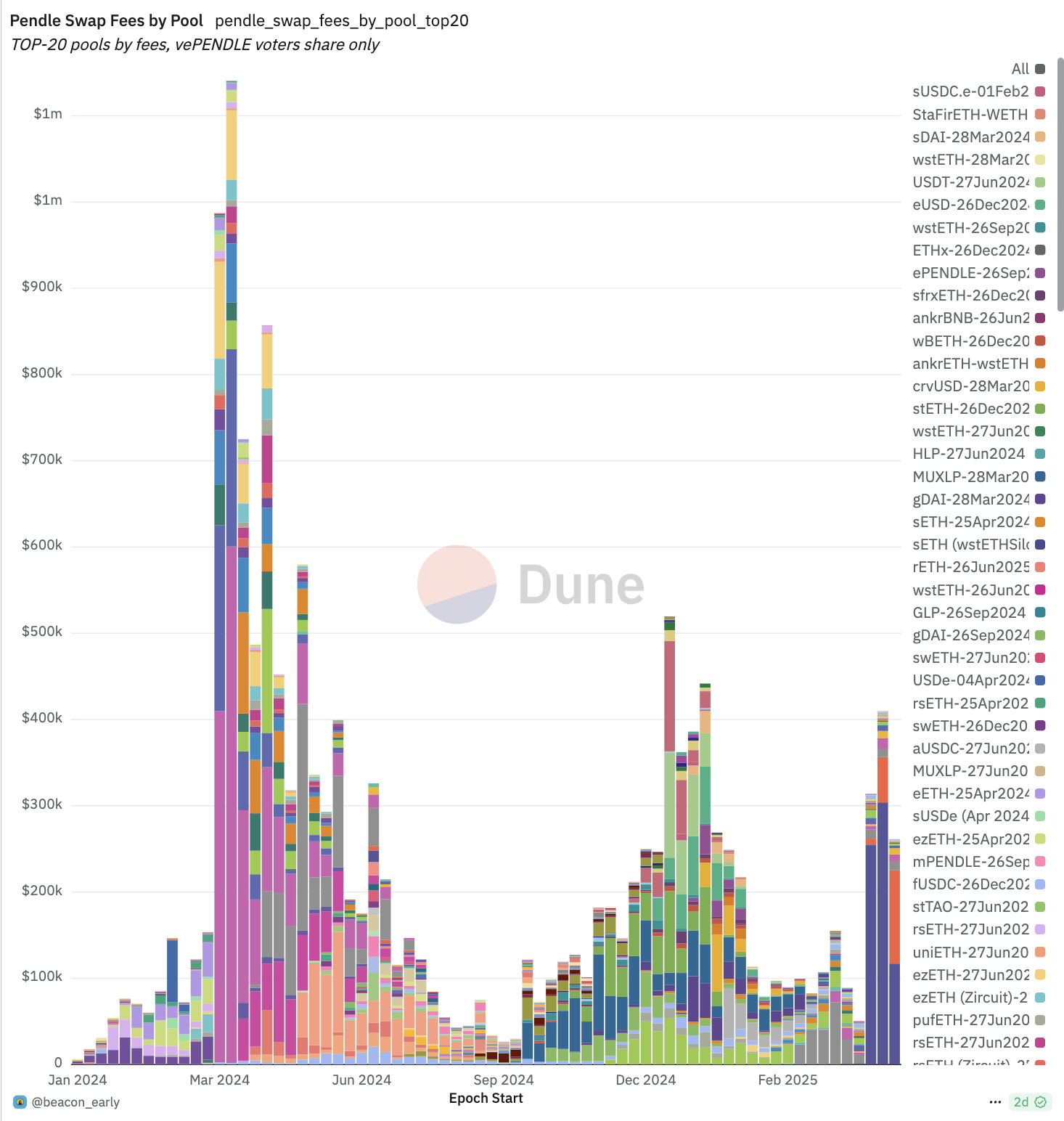
In the last round of LRT craze, with the issuance of EigenLayer, Pendle's token price once fell sharply. But with the rise of "strategic stablecoins", Pendle's TVL has achieved explosive growth. It is gradually establishing its core position as the "interest rate swap layer" of this type of asset: stablecoin issuers can sell future earnings at one time through Pendle to hedge risks, while speculators and asset managers can buy or make markets in these income streams. With the launch of more Δ-neutral and RWA hybrid income coins, Pendle's TVL, trading volume, fee income and vePENDLE ecology are all rising simultaneously. At present, it has formed a near-monopoly leading advantage in this track.
Disclaimer:
This content does not constitute any offer, solicitation, or recommendation. You should always seek independent professional advice before making any investment decision. Please note that Gate and/or Gate Ventures may restrict or prohibit all or part of the Services from restricted regions. Please read their applicable User Agreement for more information.
About Gate Ventures
Gate Ventures is the venture capital arm of Gate, focusing on investments in decentralized infrastructure, ecosystems, and applications that will reshape the world in the Web 3.0 era. Gate Ventures works with global industry leaders to empower teams and startups with innovative thinking and capabilities to redefine social and financial interaction models.
Official website: https://ventures.gate.io/
Twitter: https://x.com/gate_ventures
Medium: https://medium.com/gate_ventures



